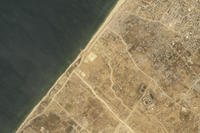 The Air Force has moved into production of its Small Diameter Bomb II that can pinpoint targets from long distances, destroy stationary or moving targets and change course in flight using a two-way data link, service officials said.
The Air Force has moved into production of its Small Diameter Bomb II that can pinpoint targets from long distances, destroy stationary or moving targets and change course in flight using a two-way data link, service officials said.
“Using its dual-band weapon data link, it can change targets in flight and can be controlled by a third party,” Col. Kevin Hickman, SDB II Program Manager, told Military.com in a written statement.
The Air Force awarded a $30.9 million deal this past June to Raytheon for an initial increment of 144 bombs.
The potential value of the entire SDB II production run is expected to be $2.792 billion for 17,000 SDB II weapons – 12,000 for the Air Force and 5,000 for the Navy, Air Force officials told Military.com
“These weapons are expected to be procured through 2025,” Air Force spokesman Ed Gulick said in a written statement.
The move toward formal production and operational status for the weapon comes on the heels of recent successful tests of the SDB II.
Several months ago, an Air Force F-15 Eagle destroyed a moving surrogate-model T-72 tank during a live-fire test of the new Small Diameter Bomb II at White Sands Missile Range, N.M., service leaders said.
The Small Diameter Bomb II represents a technological departure from previously fielded precision-guided air-dropped weapons because of its ability to track and hit moving targets from long distances.
Most of the testing of the SBD II thus far has been on an Air Force F-15 Eagle fighter jet, however, the weapon has also been fitted and tested on the F-35 Joint Strike Fighter. Engineers are also working on plans to integrate the bomb onto the F/A-18E/F Super Hornet and F-16 as well, Raytheon officials said.
GPS and laser-guided weapons such as Joint Direct Attack Munitions have been around for decades, however, they have primarily been designed for use against fixed or stationary targets.
A key part of the SDB II is a technology called a “tri-mode” seeker — a guidance system which can direct the weapon using millimeter wave radar, uncooled imaging infrared guidance and semi-active laser technology.
The seeker allows the weapon to attack stationary and moving targets at distances greater than 40 nautical miles on land and at sea, Raytheon officials said.
A tri-mode seeker provides a range of guidance and targeting options typically not used together in one system. Millimeter wave radar gives the weapon an ability to navigate through adverse weather, conditions in which other guidance systems might encounter problems reaching or pinpointing targets.
Imagining infrared guidance allows the weapon to track and hone in on heat signatures such as the temperature of an enemy vehicle. With semi-active laser technology, the weapon can be guided to an exact point using a laser designator or laser illuminator coming from the air or the ground.
Also, the SBD II brings a new ability to track targets in flight through use of a two-way Link 16 and UHF data link, Raytheon officials said.
The SBD II is engineered to weigh only 208 pounds, a lighter weight than most other air dropped bombs, so that eight of them can fit on the inside of an F-35 Joint Strike Fighter, Raytheon officials explained.
If weapons are kept in an internal weapons bay and not rested on an external weapons pod, then an aircraft can succeed in retaining its stealth properties because the shapes or contours of the weapons will not be visible to enemy radar.
Plasma Jets
About 105 pound of the SDB II is an explosive warhead which encompasses a “blast-frag” capability and a “plasma-jet” technology designed to pierce enemy armor, a Raytheon official explained.
The SDB II also has the ability to classify targets, meaning it could for example be programmed to hit only tanks in a convoy as opposed to other moving vehicles. The weapon can classify tanks, boats or wheeled targets, a Raytheon official added.
Prior to the award of this contract, the Pentagon and Raytheon have already invested more than $700 million into SBD II development, Raytheon officials said.
-- Kris Osborn can be reached at Kris.Osborn@military.com








